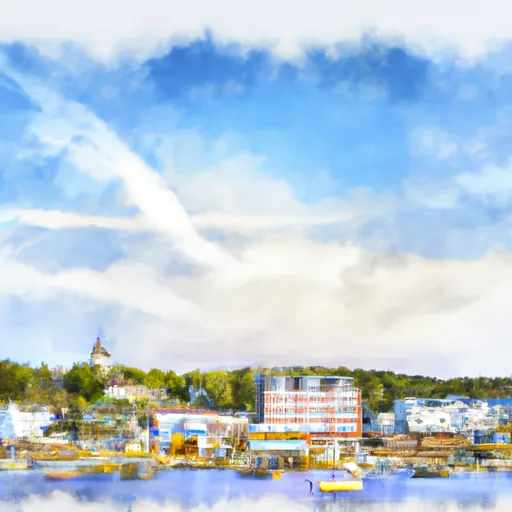-
 Snoflo Premium
Snoflo Premium
Get unlimited access to all our content
With no Ad interruptions! - Start Your Free Trial Login with existing account
Seal-Harbor
Eden Index
Climate
7.6
•
Recreation
5.5
•
Community
1.1
•
Safeguard
5.2/10

Seal Harbor is a charming village located on Mount Desert Island in Maine, United States. It offers a picturesque coastal setting and is known for its natural beauty and outdoor recreation opportunities. The climate in Seal Harbor is generally cool and temperate, with warm summers and cold winters. The region experiences moderate rainfall throughout the year.
Situated near Acadia National Park, Seal Harbor boasts stunning landscapes, including rocky shores, pristine beaches, and lush forests. The area is home to several water bodies, including Jordan Pond and the Atlantic Ocean, providing opportunities for various water-based activities like fishing, swimming, and boating.
The hydrology of Seal Harbor consists of freshwater streams, ponds, and wetlands, which support diverse ecosystems. These habitats are teeming with wildlife, making it an ideal spot for birdwatching and nature enthusiasts.
Outdoor recreation enthusiasts will find ample opportunities in Seal Harbor, including hiking, biking, and walking trails that wind through the scenic landscapes. The nearby Acadia National Park offers an extensive network of trails, ranging from easy strolls to challenging hikes with breathtaking vistas.
In conclusion, Seal Harbor in Maine offers a pleasant climate, beautiful hydrological features, and numerous outdoor recreation options, making it a perfect destination for nature lovers and adventurers alike.
What is the Eden Index?
The Snoflo Eden Index serves as a comprehensive rating system for regions, evaluating their desirability through a holistic assessment of climate health, outdoor recreation opportunities, and natural disaster risk, acknowledging the profound impact of these factors on livability and well-being.
Climate Health Indicator (CHI): 7.6
Seal-Harbor receives approximately
1439mm of rain per year,
with humidity levels near 76%
and air temperatures averaging around
8°C.
Seal-Harbor has a plant hardyness factor of
5, meaning
plants and agriculture in this region thrive during a short period during spring and early summer. Most
plants will die off during the colder winter months.
By considering the ideal temperature range, reliable water supplies, clean air, and stable seasonal rain or snowpacks, the Climate Health Indicator (CHI) underscores the significance of a healthy climate as the foundation for quality living.
A healthy climate is paramount for ensuring a high quality of life and livability in a region, fostering both physical well-being and environmental harmony. This can be characterized by ideal temperatures, reliable access to water supplies, clean air, and consistent seasonal rain or snowpacks.
Weather Forecast
Streamflow Conditions
Maine Coastal
Area Rivers
Maine Coastal
Snowpack Depths
Maine Coastal
Reservoir Storage Capacity
Maine Coastal
Groundwater Levels
Recreational Opportunity Index (ROI): 5.5
The Recreational Opportunity Index (ROI) recognizes the value of outdoor recreational options, such as parks, hiking trails, camping sites, and fishing spots, while acknowledging that climate plays a pivotal role in ensuring the comfort and consistency of these experiences.
Access to outdoor recreational opportunities, encompassing activities such as parks, hiking, camping, and fishing, is crucial for overall well-being, and the climate plays a pivotal role in enabling and enhancing these experiences, ensuring that individuals can engage in nature-based activities comfortably and consistently.
Camping Areas
| Campground | Campsites | Reservations | Toilets | Showers | Elevation |
|---|---|---|---|---|---|
| Lamoine State Park | 60 | 93 ft | |||
| Seawall - Acadia National Park | 214 | 35 ft | |||
| Blackwoods - Acadia National Park | 306 | 193 ft |
Catastrophe Safeguard Index (CSI):
The Catastrophe Safeguard Index (CSI) recognizes that natural disaster risk, encompassing floods, fires, hurricanes, and tornadoes, can drastically affect safety and the overall appeal of an area.
The level of natural disaster risk in a region significantly affects safety and the overall livability, with climate change amplifying these risks by potentially increasing the frequency and intensity of events like floods, fires, hurricanes, and tornadoes, thereby posing substantial challenges to community resilience and well-being.
Community Resilience Indicator (CRI): 1.1
The Community Resilience Indicator (CRI) recognizes that education, healthcare, and socioeconomics are crucial to the well-being of a region. The CRI acknowledges the profound impact of these elements on residents' overall quality of life. By evaluating educational resources, healthcare accessibility, and economic inclusivity, the index captures the essential aspects that contribute to a thriving community, fostering resident satisfaction, equity, and social cohesion.

